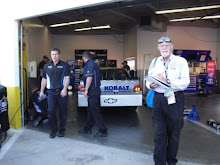Deep Thought reflects on more than an 80 g acceleration, theta, and dt
For a very funny "Onion" sort of piece by Jeff Meyer go to http://www.frontstretch.com/jmeyer/30604/
And now the real Deep Thought
There are three parts to determining what effect an acceleration has on an object, including a human body: magnitude (how much acceleration); direction (an angle, theta); and the time duration of the acceleration, dt.
Numerous medical studies have shown that a human can withstand surprisingly high accelerations, more than 100 g's (one hundred times the acceleration of gravity) provided that the duration is very short (on the order of a millisecond, 0.001 seconds).
While NASCAR has indicated the magnitude of the acceleration sustained by the 19 car, they've said nothing about where the accelerometers were placed, the direction of the acceleration or the duration of the acceleration. But then, high g accelerations make for good headlines.
The 19 car was sliding down the track as well as heading for the Armco barrier.
Note the location of the TV camera and the extreme foreshortening of its images.
Looking at the event area in more detail, indicates the path and orientation of the 19 car as it slid and rotated, heading for the Armco barrier.
Acceleration is a change in direction and/or speed of an object. Mathematically if one looks at the velocity of the car going into the impact event and the velocity of the car leaving the impact event it is possible to construct a moment diagram of the event itself.
Momentum is shown in a flat plane, with two directions X (along the Armco barrier) and Y (perpendicular to the Armco barrier); the Z direction, straight up, is the angular momentum of the object (rotation). If one takes the sum of the momentum vectors, they must close, that is the sum of momentum going in minus momentum leaving must equal zero. The dV vector is the change in velocity during the impact event.
From what little information is available on You-Tube videos it would appear that the total acceleration for the center of gravity of the 19 car was on the order of 110 g's.
The duration was very short, video frame rate is 30 frames per second, the 19 car changes from going forward to going backward between two frames, i.e., 0.033 seconds. The peak acceleration probably lasted for less than 0.008 seconds.
The short of the whole story is that the track needs to be modified, the grass area between the track and the Armco barrier is less than 100 feet, not enough to slow a car while sliding through wet grass. One of the many people who have emailed me since my previous blog post suggested sand traps such as you see in F1 tracks, good idea but not enough room. The Pocono track back stretch is scary narrow for cars going 180 or 200 mph.
Now on to Watkins Glen and the fact that in the early days of auto racing, all courses were road courses.
skip to main |
skip to sidebar

High technology side of the middle and high school STEM Education, The Ten80 Student Racing Challenge. This blog focuses on the insiders science behind racing.
Prof Pi

- Learn about Ten80 Student Racing Challenge www.studentracingchallenge.com
- Support kids in the Ten80 Student Racing Challenges-a Little League for Math and Science where we know that racing is the most dramatic demonstration of math and science in action; moreover, it is accessible to students anywhere. While I can't take you into a steel plant and show you why science and engineering are so fascinating in practice,...I can have you driving a race car, at least a 1/10th scale one. And remember, you can see any of the images full size by clicking on them.







No comments:
Post a Comment